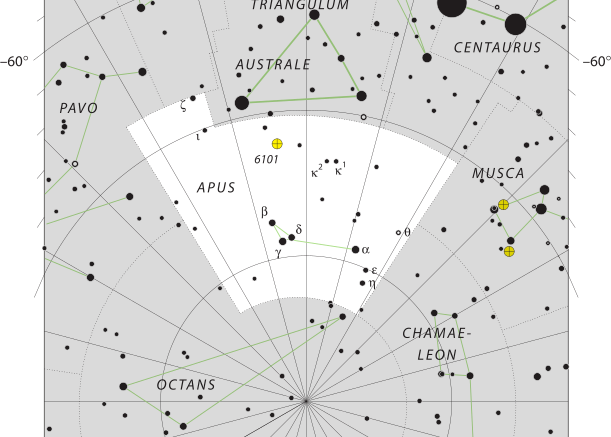Apus constellation is located in the southern hemisphere, and is a small constellation that represents the bird of paradise. The name of the constellation is derived from the Greek word apous, which means “footless.” This is a result of people at one point in history believing that birds of paradise lacked feet. There are no myths associated with the constellation. It was first depicted on a celestial globe by Petrus Plancius in 1598, and was charted on a star atlas by Johann Bayer in his 1603 Uranometria.
| Applicable Information | |
| Visibility In Pacific Northwest | Not visible |
| Best Times To View | Not visible |
| Right Ascension | 13h 51m 07.5441s – 18h 27m 27.8395s |
| Declination | −67.4800797° to −83.1200714° |
| Area | 206 sq. deg. |
| Main Stars | 4 |
| Brightest Object | α Aps (3.83m) |
| Meteor showers | 0-None |
| Messier objects | 0-None |
| Neighboring Constellations | Triangulum Australe, Circinus, Musca, Chamaeleon, Octans, Pavo, Ara |
The Name
Apus was created by the Dutch astronomer and cartographer Petrus Plancius from the observations of Dutch navigators Pieter Dirkszoon. Keyser and Frederick Houtman, and first catalogued by Plancius in the late 16th century.
After its introduction on Plancius’s globe, the constellation’s first known appearance in a celestial atlas was in German cartographer Johann Bayer’s Uranometria of 1603.[1] Bayer called it Apis Indica while fellow astronomers Johannes Kepler and Jakob Bartsch called it Apus or Avis Indica.[2] The name Apus is derived from the Greek apous, meaning “without feet”. As Westerners hadn’t seen a bird of paradise with its wings and feet, they assumed that the bird had no feet.
Stars
Of the deep-sky objects in Apus, there are two prominent globular clusters—NGC 6101 and IC 4499—and a large faint nebula that covers several degrees east of Beta and Gamma Apodis. NGC 6101 is a globular cluster of apparent magnitude 9.2 located around 50,000 light-years distant from Earth, which is around 160 light-years across.
Make sure to check out other articles on the site, including a brief introduction to constellations, other constellation articles, and more!
Sources
[1] = Ridpath, Ian. “Johann Bayer’s Southern Star Chart”. Star Tales.
[2] = Wagman, Morton (2003). Lost Stars: Lost, Missing and Troublesome Stars from the Catalogues of Johannes Bayer, Nicholas Louis de Lacaille, John Flamsteed, and Sundry Others. Blacksburg, Virginia: The McDonald & Woodward Publishing Company. pp. 30–32. ISBN 978-0-939923-78-6.

Be the first to comment on "Apus"